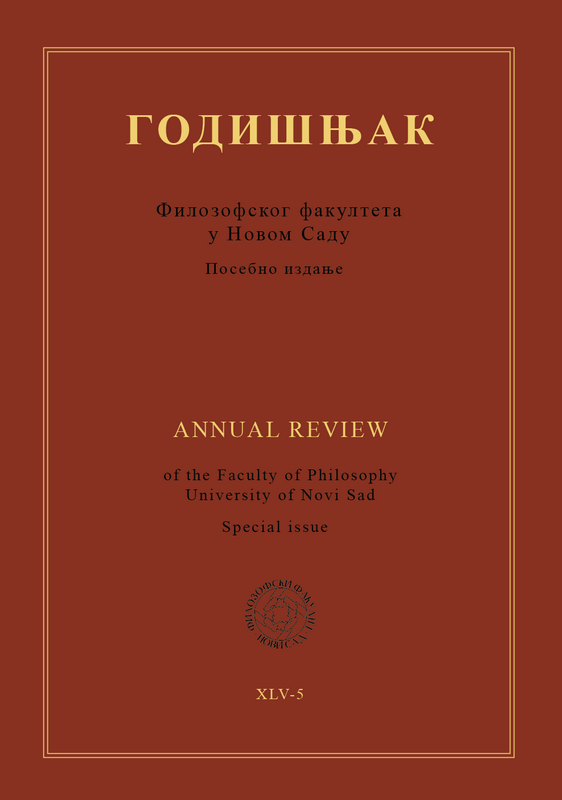ISTRAŽIVANJE VEŠTINE ANALIZE TEKSTA NA ENGLESKOM KAO STRANOM: POREĐENJE EKSPLICITNIH I IMPLICITNIH ZADATAKA
Главни садржај чланка
Сажетак
Ovaj rad ima za cilj da ponudi odgovor na pitanje da li, ukoliko kao faktor kontrolišemo znanje engleskog jezika, nivo razvoja veštine čitanja predstavlja značajan prediktor uspeha koji studenti koji uče engleski jezik kao strani postižu prilikom rešavanja zadataka na testu razumevanja teksta koji su usmereni na lokalne, odnosno eksplicitno navedene informacije, s jedne strane, i globalne, odnosno informacije koje zahtevaju izvođenje zaključaka i razumevanje celovitosti teksta, njegove strukture i svrhe, s druge? U tu svrhu, ukupno 38 studenata koji pohađaju nastavu engleskog jezika kao izbornog predmeta na Filozofskom fakultetu u Novom Sadu uradilo je test razumevanja teksta koji se sastojao od pitanja koji testiraju lokalne tekstualne informacije (lociranje činjenica, parafraziranje informacija, prepoznavanje navedenih činjenica) i globalne tekstualne informacije (identifikovanje glavnih ideja i uspostavljanje referentnih veza). Učesnici su prvo podeljeni na uspešne i manje uspešne čitaoce na osnovu rezultata testiranja, a zatim su upoređeni pomoću analize kovarijanse (ANCOVA). Rezultati pokazuju da se učesnici razlikuju u sposobnosti identifikovanja činjenične informacije i izvođenja zaključaka na osnovu navedenih informacija spram nivoa razvoja veštine čitanja, a u manjoj meri i spram nivoa poznavanja stranog jezika, ali ne i kao rezultat interakcije između ova dva faktora. Ovaj rezultat nudi praktičnu podršku u korist hipoteze jezičke međuzavisnosti, koja predlaže da je čitanje na stranom jeziku u velikoj meri povezano sa veštinom čitanja na maternjem jeziku i sa nezavisnom veštinom čitanja koja nije vezana za neki određeni jezik. Pored toga, studenti sa slabijim nivoom znanja jezika i nedovoljno razvijenom veštinom čitanja imali su više poteškoća pri rešavanju zadataka koja su zahtevala holističko razumevanje teksta, što navodi na zaključak da ovi čitaoci obrađuju tekst koristeći strategije odozdo prema gore.
Downloads
Детаљи чланка
Референце
Becker, A. (2016). L2 students’ performance on listening comprehension items targeting local and global information. Journal of English for Academic Purposes, 24, 1-13.
Bernhardt, E. (2011). Understanding advanced second language reading. New York: Routledge.
Bernhardt, E. & Kamil, M. (1995). Interpreting relationships between L1 and L2 reading: Consolidating the Linguistic Threshold and the Linguistic Interdependence Hypotheses. Applied Linguistics, 16, 15-34.
Block, E. (1992). See how they read: Comprehension monitoring of L1 and L2 readers. TESOL Quarterly, 26, 319-342.
Carrell, P. (1988). Some causes of text-boundedness and schema interference in ESL reading classrooms. In: Carell, P.-Devine, J. & Eskey, D. (eds.) (1988). Interactive Approaches to Second Language Reading. Cambridge: Cambridge University Press. 239-259.
Carver, R. (1997). Reading for one second, one minute, or one year from the perspective of reading theory. Scientific Studies of Reading, 1(1), 3-43.
Clarke, M. (1988). The short circuit hypothesis of ESL reading – or when language competence interferes with reading performance. In: Carrel, P.-Devine, J. & Eskey, D. (eds.) (1988). Interactive approaches to second language reading. Cambridge: Cambridge University Press. 114-124.
Coady, J. (1979). A psycholinguistic model of the ESL reader. In: Mackay, R.- Barkman, B. & Jordan, R. (eds.) (1979). Reading in a Second Language. Rowley, MA: Newbury House. 5-12.
Cohen, A. & Upton, T. (2006). Strategies in responding to the new TOEFL reading tasks (TOEFL Monograph No. MS-33). ETS: Princeton, NJ
Cohen, J. (1988). Statistical power analysis for the behavioral sciences (2nd Edition). Hillsdale, NJ: Lawrence Erlbaum Associates, Publishers.
Devine, J. (1988). The relationship between general language competence and second language reading proficiency: Implications for teaching. In: Carrell, P. L.-Devine, J. & Eskey, D. (eds.) (1988). Interactive approaches to second language reading. New York: Cambridge University Press. 261-277.
Enright, M.-Grabe, W.-Koda, K.-Mosenthal, P.-Mulcahy-Ernt, P. & Schedl, M. (2000). TOEFL 2000 reading framework: A working paper (TOEFL Monograph Series Report No. 17). Princeton: Educational Testing Service.
ETS – Educational Testing Service. (2009). The official guide to TOEFL® Test. New York: McGraw-Hill.
Goldman, S. R. (1997). Learning from text: Reflections on the past and suggestions for the future. Discourse Processes, 23/3, 357-398.
Grabe, W. (2009). Reading in a second language: Moving from theory to practice. Cambridge: Cambridge University Press.
Hansen, C., & Jensen, C. (1994). Evaluating lecture comprehension. In: Flowerdew, J. (ed.) (1994) Academic listening. New York: Cambridge University Press. 241-268.
Jamieson, J.-Jones, S.-Kirsch, I.-Mosenthal, P. & Taylor, C. (1999). TOEFL 2000 framework: A working paper (TOEFL Monograph No. MS-16). Princeton, NJ: ETS.
Khalifa, H., & Weir, C. J. (2009). Examining reading: Research and practice in assessing second language reading. Cambridge: Cambridge University Press.
Kong, J. (2019). Investigating the role of test methods in testing reading comprehension. Singapore: Springer.
Landau, S. & Everitt, B. (2004). A handbook of statistical analyses using SPSS. New York: Chapman & Hall/CRC.
Lim, H. J. (2017). Exploring test takers’ cognition in a high-stakes reading test: An eye-tracking study. The Journal of Asia TEFL, 14/3, 482-500.
Mackay, R. (1979). Teaching the information-gathering skills. In: Mackay, R.- Barkman, B. & Jordan, R. (eds.) (1979). Reading in a second language. Rowley, MA: Newbury House. 79-90.
Maxwell, S. & Delaney, H. (1990). Designing experiments and analyzing data. Stamford, CT: Wadsworth.
Oxford University Press/University of Cambridge/Association of Language Testers in Europe (2001). Quick placement test: Paper and pen test. Oxford: Oxford University Press.
Perfetti, C. A. (1997). Sentences, individual differences, and multiple texts: Three issues in text comprehension. Discourse Processes, 23/3, 337-355.
Rumelhart, D. (1977). Toward an interactive model of reading. In: Dornic, S. (ed.) (1977). Attention and Performance. Hillsdale, NJ: Erlbaum. 573-603.
Samuel, J. & Kamil, M. (2002). Models of the reading process. In: Pearson, D. (ed.) (2002). Handbook of Reading Research, Volume 1. Mahwah, NJ: Lawrence Erlbaum. 185-224.
Shohamy, E., & Inbar, O. (1991). Validation of listening comprehension tests: The effect of text and question type. Language Testing, 8, 23-40.
Stanovich, K. (1980). Toward an interactive-compensatory model of individual differences in the acquisition of literacy. Reading Research Quarterly, 16/1, 32-71.
Urquhart, A., & Weir, C. (1998). Reading in a second language: Process, product and practice. New York: Longman.




